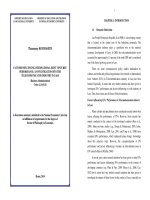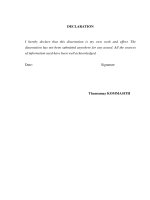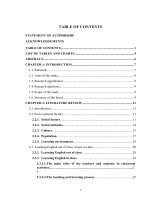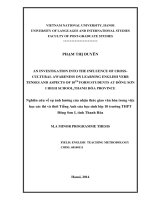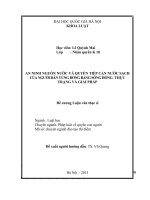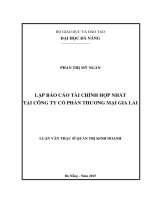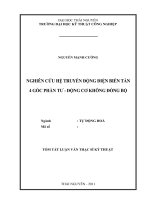(Luận văn thạc sĩ) an investigation into the common errors in pronouncing word final consonants s, z, t faced by six year old students at phu xuyen primary school
Bạn đang xem bản rút gọn của tài liệu. Xem và tải ngay bản đầy đủ của tài liệu tại đây (2.22 MB, 72 trang )
VIETNAM NATIONAL UNIVERSITY, HANOI
UNIVERSITY OF LANGUAGES AND INTERNATIONAL STUDIES
FACULTY OF POST-GRADUATE STUDIES
*****************
LÊ PHƯƠNG LAN
AN INVESTIGATION INTO THE COMMON ERRORS IN
PRONOUNCING WORD - FINAL CONSONANTS /S/, /Z/, /T/ FACED BY
SIX YEAR-OLD STUDENTS AT PHU XUYEN PRIMARY SCHOOL
(Điều tra về lỗi phổ biến của học sinh lớp 1 trường tiểu học
Phú Xuyên khi phát âm phụ âm cuối /s/, /z/, /t/ của từ)
M.A. PROGRAMME MINOR THESIS
Field:English Teaching Methodology
Code: 60140111
HANOI, 2015
VIETNAM NATIONAL UNIVERSITY, HANOI
UNIVERSITY OF LANGUAGES AND INTERNATIONAL STUDIES
FACULTY OF POST-GRADUATE STUDIES
*****************
LÊ PHƯƠNG LAN
AN INVESTIGATION INTO THE COMMON ERRORS IN
PRONOUNCING WORD - FINAL CONSONANTS /S/, /Z/, /T/ FACED BY
SIX YEAR-OLD STUDENTS AT PHU XUYEN PRIMARY SCHOOL
(Điều tra về lỗi phổ biến của học sinh lớp 1 trường tiểu học
Phú Xuyên khi phát âm phụ âm cuối /s/, /z/, /t/ của từ)
M.A. PROGRAMME MINOR THESIS
Field:English Teaching Methodology
Code: 60140111
Supervisor: Ph.D. Phạm Thị Thanh Thùy
HANOI, 2015
CANDIDATE’S STATEMENT
I hereby certify that the minor thesis entitled “An investigation into the
common errors in pronouncing word-final consonants /s/, /z/, /t/ faced by 6 year-old
students at Phu Xuyen primary school” is completely my own research which carried
out at Phu Xuyen primary school during the whole school-year since 2012, and the
thesis has not been submitted for any degree at any other university or institution.
Hanoi, August 16th, 2015
Lê Phương Lan
i
ACKNOWLEDGEMENTS
First and foremost, I would like to express my deepest gratitude to my
supervisor, Mrs. Pham Thi Thanh Thuy, Ph.D for her invaluable supervision,
constructive criticism, and enthusiastic encouragement without which the writing of
this thesis would not have been successfully completed.
Secondly, my sincere thanks are sent to Mr. Eduardo Culbeaux from the English
Language Institute for his assistance in three experimental recording tasks and
especially for his comments about the data collection procedure.
Thirdly, I am thankful to the lecturers and staff of the Faculty of Post –
Graduate Studies at the University of Languages and International Studies for their
scientific knowledge, enthusiastic guidance during my course.
My high appreciation and gratitude also extend to all the 6-year-old students at
Phu Xuyen primary school for their contribution to the reliability of this study.
Last but not least, I owe my deep thanks to my family, my friends who keep
encouraging me to complete this work.
ii
ABSTRACT
Being a teacher, an observer and researcher of Grade 1 classes at Phu Xuyen
primary school for the whole school-year since 2012, seeing a lot of mispronunciation
errors happened, the researcher must conduct this case study research as a matter of
urgency to help students to overcome these errors from the early school.
Two classes with 35 students naturally participated in the study through three
experimental recording tasks and the basic questionnaire in Vietnamese. The
quantitative data gathered will provide readers with many reliable results relating to
most problematic ending consonant sounds, the common errors in pronouncing these
sounds, the causes as well the possible solutions to deal with such errors.
The results reveal the following concerning information. Firstly, most of the
subjects of the study struggle many difficulties in pronouncing the ending sound
consonants /s/, /z/, /t/. Secondly, the most common errors were sound omitted, sound
confusion and sound redundancy. The causes leading to such errors were mainly the
direct imitation of the teacher or friends‟ sounds, the lack of detailed instruction on the
pronunciation of isolated consonant sounds and the students‟ laziness. To help students
pronounce more correctly, some strategies are being applied effectively such as the
media/ software with the standard pronunciation of the native for students to listen and
read aloud, encouraging students to ask for help from others and requiring students to
practice as much as possible. With limitations of the minor thesis, it is hoped that the
study will be useful for other teachers or researchers with the passion for improving
students‟ pronunciation, especially pronunciation with the word-final consonant
sounds.
iii
TABLE OF CONTENTS
CANDIDATE’S STATEMENT……………………………………………………. i
ACKNOWLEDGEMENTS………………………………………………………… ii
ABSTRACT…………………………………………………………………………. iii
TABLE OF CONTENTS…………………………………………………………… iv
LISTS OF TABLES………………………………………………………………… vii
LISTS OF FIGURES……………………………………………………………….. viii
PART A – INTRODUCTION ……………………………………………………... 1
1.
Statement of the problem and rationale of the study …………………......... 1
2.
Aims of the study ………………………………………………………….... 2
3.
Research questions ………………………………………………………… 3
4.
Scope of the research ………………………………………………………. 3
5.
Significance of the study …………………………………………………... 3
6.
Organization of the study ………………………………………………...... 4
PART B – DEVELOPMENT ……………………………………………………… 5
CHAPTER 1: LITERATURE REVIEW …………………………………………. 5
1.1.
English consonants in general……………………………………………… 5
1.1.1.
Phonological characteristics and articulation of the sound /t/……………… 6
1.1.2.
Phonological characteristics and articulation of the sound /s/……………… 7
1.1.3.
Phonological characteristics and articulation of the sound /z/……………... 7
1.2.
Word-final consonants……………………………………………………… 8
1.2.1.
English word-final consonants……………………………………………... 8
1.2.2.
Vietnamese word-final consonants…………………………………………. 8
1.2.3.
Comparison between Vietnamese and English word-final consonants……… 10
1.3.
Pronunciation errors………………………………………………………... 11
iv
1.3.1.
Errors and Mistakes………………………………………………………… 11
1.3.2.
Pronunciation errors………………………………………………………... 12
1.3.3.
Description of errors………………………………………………………... 12
1.3.4.
Explanation of errors……………………………………………………….. 13
1.4.
Previous works……………………………………………………………... 13
CHAPTER 2: METHODOLOGY………………………………………………… 18
2.1.
Research design…………………………………………………………….. 18
2.2.
Participants of the study…………………………………………………..... 18
2.3.
Data collection procedure…………………………………………………… 19
2.4.
Data analysis procedure…………………………………………………….. 21
CHAPTER 3: FINDINGS AND DISCUSSIONS ………………………………… 23
3.1.
Common errors in pronunciation……………………………………………. 23
3.1.1.
Errors with ending sound /z/………………………………………………… 24
3.1.2.
Errors with ending sound /s/………………………………………………… 24
3.1.3.
Errors with ending sound /t/………………………………………………… 26
3.2.
Sources of error reasons in 3 ending consonants…………………………….. 27
3.2.1.
Internal reasons……………………………………………………………… 27
3.2.1.1. Origin………………………………………………………………………. 27
3.2.1.2. Hobbies………………………………………………………………………. 28
3.2.2.
External reasons……………………………………………………………… 30
3.2.2.1. Reasons from teachers……………………………………………………… 30
3.2.2.2. Reasons from textbook……………………………………………………… 30
3.3.
Suggestions to remove problems……………………………………………. 31
3.3.1.
Phonics with consonants emphasis and practice…………………………… 31
3.3.2.
Phonics with self-correction program ………………….…………………… 32
v
PART C – CONCLUSION ………………………………………………………… 35
1.
Summary of findings………………………………………………………….. 35
2.
Concluding marks…………………………………………………………….. 35
3.
Teaching recommendations…………………………………………………… 37
4.
Limitations and suggestions for further research…………………………….. 38
REFERENCES……………………………………………………………………… 40
APPENDIX 1………………………………………………………………………… I
APPENDIX 2………………………………………………………………………… III
APPENDIX 3………………………………………………………………………… XIV
APPENDIX 4………………………………………………………………………… XV
APPENDIX 5………………………………………………………………………… XVIII
APPENDIX 6………………………………………………………………………… XXI
vi
LISTS OF TABLES
Table 1
: English consonants
Table 2
: Vietnamese initial consonants
Table 3
: Vietnamese final consonants
Table 4
: Common errors found in the data
Table 5
: More problematic consonants
Table 6
: Number of subjects with errors in pronouncing the ending sound /z/
and types of errors in isolated words
Table 7
: Number of subjects with errors in pronouncing the ending sound /s/
and types of errors in isolated words
Table 8
: Number of subjects with errors in pronouncing the ending sound /t/
and types of errors in isolated words
Table 9
: Students‟ opinion about the causes of errors
Table 10
: Students' reflection on their teacher‟s strategies to help them to
overcome the errors
Table 11
: Students‟ self-strategies to correct the errors
vii
LISTS OF FIGURES
Figure 1
: Articulation of the sound /t/
Figure 2
: Articulation of the sound /s/
Figure 3
: Articulation of the sound /z/
Figure 4
: Students' perceptions of the difficulty of pronouncing the word-final
consonants
Figure 5
: Percentage of students‟ opinion about the causes of errors
Figure 6
: Percentage of Students' reflection on their teacher‟s strategies
Figure 7
: Percentage of students‟ frequencies of applying these self-strategies.
viii
PART A – INTRODUCTION
1.
Statement of the problem and rationale of the study
English language has become an international language that is widely used by a large
number of people from many countries for the purposes of communication, further
studying career or seeking better jobs in foreign companies. (Crystal, 2003) Towards
the importance of this language, the Decision No 1400/QĐ – TTg on September 30th
2008 by the Prime Minister Government emphasized that foreign language should be
taught in the national education system at all levels includes training levels. To meet
the demand, the principal of Phu Xuyen primary school has decided to choose one of
the English programs that are allowed by Ministry of Education to implement. The
Phonics Learning Box United Kingdom program has been applied in this school since
2010 with the aim of providing students a chance to access an international language
from the first grade of a primary school.
It is said that the target of learning any foreign language is through the success of
communication in the detailed daily-life contexts. However, very few people can reach
this ideal target since learners have many serious common errors in pronunciation,
which causes the breakdown of communication. The reason here is “a learner who
consistently mispronounces a range of phonemes can be extremely difficult for a
speaker from another language community to understand” (Kelly, 2000:11). According
to Celce – Murcia (1985), mastering grammar rules and having a rich vocabulary are
important for learners but these important things would become useless if learners
could not pronounce exactly structures or words. Sharing the view, Hinofitis and Baily
(1980, as cited in Ha, 2005) reported that up to a certain proficiency standard, the fault
that most severely impaired the communication process in English foreign learners was
pronunciation, rather than vocabulary or grammar. To deal with these problems, there
are 70 learning periods for 2 semesters during the school year in the Phonics program.
1
With this syllabus, students will have 2 periods per week to develop comprehensively 4
English skills, reading – writing – listening – speaking. In addition, these students have
a chance to learn English pronunciation quite frequently. Specifically, every period,
two Vietnamese teachers are required to help students to practice pronouncing English
sounds, words and short sentences. The other compulsory is that teachers have to
design the supplementary activities and check students‟ pronunciation errors,
especially the errors with word ending sounds. When being implemented, this English
program is hoped to help students with bettering speaking and communication skills.
In fact, since the facts of observing many first - grade classes of Phu Xuyen primary
school, a number of mispronunciation errors produced by many 6-year-old students.
Among the pronunciation errors that students are likely to make (i.e. intonation, word
and sentence stress, linking sounds, ending sounds, etc.), errors with word-final
consonants can be seen as the most serious. According to the result of earlier research
by the Australian Government publication Asian Language Motes (1978, as cited in
Pham, 2009), Vietnamese students face many difficulties in pronouncing final clusters
instead of initial clusters. Also based on the research on common problems of
Vietnamese learners, “English consonant clusters give Vietnamese learners problems
not only because they do not have these combinations in theirs own language, but also
because they produce a variety of syllable types‟ (as cited in Nguyen, 2011). The
finding from Nguyen (2004, as cited in Pham, 2009) showed that 100% participants
have problems with ending sounds. Due to the importance of pronunciation in
communication, this study is expected to examine the facts of common errors of 6year-old students at Phu Xuyen primary school when dealing with many word-final
consonants /s/, /z/, /t/.
2.
Aims of the study
The purpose of this study is investigating the common errors made by 6 year-old
students at Phu Xuyen primary school to:
2
-
Identify the situation of errors made when pronouncing word-final consonants:
/s/, /z/ and /t/ faced by those learners;
-
Find out the causes of the errors;
-
Provide some suggestions assisted by Phonics Program for both teachers and
students to overcome the errors.
It is hoped that the study will be considered as a useful document for both teachers and
students to better their teaching and learning pronunciation.
3.
Research questions
The study is expected to find answers to the following questions:
1) What is the situation of errors made when pronouncing word-final consonants:
/s/, /z/ and /t/?
2) Why do 6 year-old students make those errors?
3) What are some possible solutions assisted by Phonics Program in helping
teachers and students to correct those errors?
4.
Scope of the research
English sounds consist of 44 sounds with 20 vowels sounds and 24 consonants. In fact,
Vietnamese students do not have errors with all the English vowels and consonants.
Also, due to the limited time and the scale of the minor thesis, the researcher only
focuses on 3 word-final consonants /s/, /z/ and /t/ made by 6 year-old students at Phu
Xuyen primary school where the researcher has visited many times to observe the
learning process of these participants during the whole school-year.
5.
Significance of the study
Even though there have been numerous studies on word-final consonant errors, few
investigations into errors in the production of such consonants as /s/, /z/ and /t/. The
participants for those early studies focus on students at high school or at the university
and research on young learners in English has not received much attention. The process
of data collection is stressful for participants, especially, participants with lower
3
English proficiency. Specifically, researchers test each student in a separate room and
student was required to finish the given tasks. Then, to remove this problem, this study
is intended to collect data in the most natural possible way to get the most effective
result through games and activities. Another problem in previous studies was about the
ones with analyzing the data. There was no standard software or native speakers‟
participation; thus, this study will fix this problem by engaging the native speaker to
evaluate students‟ errors through the recordings with clear criteria. These
improvements above are hoping to provide an insight into the common errors in
pronouncing word-final consonants /s/, /z/, /t/ of 6-year-old students at Phu Xuyen
primary school.
6.
Organization of the study
The study consists of three main parts as follow.
The first part concluding “Introduction” deals with statement of the problem, rationale,
aims, research questions, scope, significance, methodology with briefly introducing
design, participants, data gathering instruments and data analysis procedure.
Part B is the development with three chapters. Chapter 1 “Literature review” is
devoted to the theoretical background and a critical analysis of some related studies.
Chapter 2 “Methodology” describes the research methodology with the description of
the participants, a plan to collect adequate and reliable data for analysis including the
research gathering instruments and procedures of data collection as well as procedures
of data analysis. The next chapter “Findings and Discussions” mainly deals with the
findings from collecting and analyzing the research data.
Part C, the Conclusion concerns concluding marks, implications with some
recommendations for correcting word-final consonant errors of 6-year-old students.
Besides, the study provides some suggestions for further research on this topic.
4
PART B – DEVELOPMENT
CHAPTER 1: LITERATURE REVIEW
In this chapter, the researcher provides readers with the relevant literature of the study
by introducing some key concepts for understanding the research, as well as the review
of previous studies related to the topic. Some crucial concepts need to be clarified in
this part are consonants in general, word-final consonants particularly in English and in
Vietnamese. To understand many difficulties of Vietnamese learners when dealing
with word-final consonants, the comparison between English and Vietnamese final
consonants is illustrated. Then, the theoretical background in pronunciation error will
be critically presented to better the knowledge base of the study.
1.1.
English consonants in general
According to Peter Roach (2000), consonants are sounds that are “difficult or
impossible for the air to pass through the mouth”. The author emphasized that these
sounds do not really obstruct the flow of air. Jones (1972) stated all sounds which are
voiced, in the production of which the air has an impeded passage through the mouth
(/b/, rolled /r/), in the production of which the air does not pass through the mouth (/g/,
/m/), in which there is an audible friction (/f/, /v/, /s/, /z/, /b/), are called consonants.
There are 24 consonants in the English consonant system (Table 1). Then, the criteria
to categorize each consonant are the place of articulator, the manner of articulation and
voicing. According to Kelly (2000) and Peter Roach (2000), 24 consonants are divided
into 6 groups:
Plosive
Nasal
Fricative
Lateral
Affricative
Approximant
5
Table 1: English consonants (Duong, 2009)
Manner of
articulation
Stop
Fricative
Affricative
Voice
Labial
voiceless
Voiced
voiceless
Labiodental
/p/
/b/
/f/
Voiced
Place of articulation
InterAlveoAlveolar
dental
palatal
/t/
/d/
/θ/
/s/
/ʃ/
/v/
/ð/
Glottal
/k/
/g/
/ʔ/
/h/
/ʒ /
/z/
/ʧ/
voiceless
Voiced
Nasal
Voiced
Approximant Voiced
Lateral
Voiced
Velar
/ ʤ/
/m/
/w/
/n/
/r/
/l/
/ŋ/
/j/
As can be seen in figure 1, consonant sounds /s/ and /z/ are alveolar fricative while /t/
and /d/ are alveolar stop. To further seeking information about the sounds /s/, /z/, and
/t/, it is necessary that phonological characteristics and articulation of each sound are
investigated.
1.1.1. Phonological characteristics and articulation of the sound /t/
/t/ is alveolar stop and to make this sound, “the tongue blade is pressed against the
alveolar ridge (Figure 1). Normally the tongue does not touch the front teeth as it does
in the dental plosives found in many languages”. (Roach, 2000).
Figure 1: (As retrieved from
/>english/frameset-ad3.html)
In comparison with the sound /d/, the
strong stop /t/ is aspirated. For example, to pronounce the word “too”, /thu:/, we have to
put the tongue tip on the very centre of the alveolar ridge and only the very point of the
6
tongue is in contact, not the blade; then allow the air to burst out with a voiceless
vowel /u:/
1.1.2. Phonological characteristics and articulation of the sound /s/
According to Peter Roach (2000), /s/ Figure 2: (As retrieved from
is alveolar fricative with the same />articulation as /t/, the air escapes h/frameset-ad3.html)
through a narrow passage along the
centre of the tongue, and the sound
produced is comparatively intense.
(Figure 2).
O‟Connor (1975) suggested that to feel the strong friction /s/, we make small changes
in the position of the tip and blade if the tongue until the cold air is hitting the tongue at
the very centre if the alveolar ridge, not further forward and not further back.
1.1.3. Phonological characteristics and articulation of the sound /z/
/s/ and /z/ are alveolar fricative with the Figure 3:(As retrieved from
nearly same articulation but /z/ is quite />weak, short and may be voiced. glish/frameset-ad3.html)
(O‟Connor, 1975). The articulation of the
sound is shown in figure 3.
7
1.2.
Word-final consonants
1.2.1. English word - final consonants
The English language has 24 consonants and most of them can occur in word-initial
position, word-medial position and word-final position except for some sounds /h/, /ʒ/.
About the position of final consonants, Yule (2006) showed the basic structure of a
syllable found in English.
Syllable
Onset
Rhyme
Nucleus
Vowel
Consonant
Coda
Consonant (s)
According to Rachael (2003), there can be up to 4 consonants in a coda:
If there are no consonants at the end of the word, it has zero coda. e.g. go /ɡoʊ/
A single consonant is called the final consonant. Any consonant except for /h/, /r/,
/w/, /j/ may be a final coda. e.g. cat /kᴂt/, price / praɪs/
When there are two or more consonants standing at the end of the word, the term
“pre-final” and “post-final” are used.
Two consonant clusters. e.g. help /help/, bank /bæŋk/
Three consonant clusters. e.g. next /nekst/
Four consonant clusters. e.g. prompts /prɒmpts/
1.2.2. Vietnamese word-final consonants
Vietnamese is a tone, monosyllabic language, and its consonants are classified into 22
initial consonants and 6 final consonants. (Seen in Table 2 and Table 3).
Table 2: Vietnamese initial consonants (Duong, 2009)
Place of articulation/ Manner
of articulation
Stop
Aspirated
UnVoiceless
aspirated
Voiced
Nasal
Labial
b
m
Place of articulation
AlveoAlveolar
Palatal
Velar
palatal
ť
ć
k
t
ţ
d
n
ŋ
8
Glottal
Ɂ
ɲ
Fricative
x
Voiceless
f
s
ş
Voiced
v
z
ȥ
Nasal
h
ɤ
I
Table 3: Vietnamese final consonants (Duong, 2009)
Place of articulation/
Manner of articulation
Labial
Alveolar
Velar
Stop
p
t
k
ŋ
Nasal
m
n
According to Nguyen (2007), “the tone of each Vietnamese syllable structure covers
the whole syllable and only the nuclear vowel is compulsory”
Tone
Initial consonants
Labialization
Nuclear vowel
Final consonant/Semi-vowel
Based on Doan (1999, as cited in Nguyen, 2007), Vietnamese final consonants are
given in detail as follow.
i.
ii.
iii.
/m/ in words like em [ɛɯ] (I, younger sister/brother), lượm [lɯɪɤ:m] (pick up), nghiêm
[ŋiem] (strict)
/n/ in word like ăn [an] (eat), làm [la:m] (do), phiên [fien]
/ŋ/: there are three allophones of this phoneme:
[ŋm]: bilabialized, produced by rounded vowels /u, o, ɔ/ - xong [soŋm], súng [ʃuŋm]
không [xoŋm]
[ŋ]: corresponding to letters „nh‟, proceded by front vowels /i, e, ɛ/ - bệnh [beŋ], tình
iv.
[tiŋ], nhanh [ŋaŋ]
[ŋ]: elsewhere - tặng [taŋ], thiêng [thieŋ], chuộng [cuoŋ]
/p/: with no air released after pronunciation, in words like úp [up], Pháp [fap], tiếp [tiep]
v.
/t/: in English , [t] ending is pronounced both as [t] and [ʔ], but in Vietnam it is always
pronounced shortly and sharply without aspiration such as ớt [ɤ:t], giết [ziet], ghét [gɛt]
9
vi.
/k/: this sound is produced where the letter “c”, “ch” is shown at the final position of a
syllable and it is agreed by many linguistics that this phoneme has 3 allophones which
appear in a complementary distribution.
[kp]: this ending sound is bilabialized if the consonant is preceded by round vowels /u,
ɒ, ɔ] - ngọc [ŋɔkp], cốc [kp], nhục [kp]
[c]: preceded by front vowels /i, e, ɛ/, performed by letters “ch” - nghịch [ŋic], lệch [lec],
sách [sa:c]
[k]: elsewhere - nhác [ŋa:k], bực [bɯk], luộc [luok]
vii.
viii.
/w/: this final semi-vowel only appears in forms of letters “u” or “o” which follow
vowels to make dipthongs or triphthongs, for example, đau [da:w], vào [va:w], đều
[dew]
/j/: appears in forms of “i” or “y” and is preceded by vowels to make diphthongs and
triphthongs - tay [ta:j], dài [da:j]
1.2.3. Comparison between Vietnamese and English word-final consonants
Above the structure of any syllable in English and Vietnamese, basically, there must be
a consonant, a vowel and a coda. Nevertheless, the major difference between these
languages is a coda in each language. Vietnamese sounds accept either a vowel or a
consonant to be a coda. On the contrary, only consonant is considered as a coda in
English syllable. For example, the final sound in the word “đau” is a semi-vowel /ṷ/. In
English, if the final sound is vowel like in the word go /ɡəʊ/, it is a zero coda with no
consonant in the final position.
From all the examples above, it is obvious that most of the English consonants can
stand at flexible positions, either in word-initial or in word-medial or in word-final one.
However, almost all of the Vietnamese consonants occur in word-initial position.
Besides, the English final consonants may consist of single or consonant clusters that
are made from more than two final consonants that follow each other. These consonant
clusters cannot be found in the Vietnamese consonantal system.
10
In this study, three final consonant sounds /s/, /z/, /t/ are investigated between two
languages. However, only the sound /t/ can be found at the final position in two
languages. The sounds /s/, /z/ do not stand at the final position of the English words.
(as can be seen in Table 1 and Table 3).
For these above differences between the two languages, it is reasonable that
Vietnamese learners seem to have obstacles when pronouncing the English word-final
consonants. Honestly, students also tend to forget to pronounce and release the English
consonants in word-final position or even if they can be aware of the English final
consonant sounds, they still make serious errors.
1.3.
Pronunciation errors
1.3.1. Errors and Mistakes
Errors and mistakes are very common in learning any new foreign language. Lennon,
(1991, cited in Ellis, 2008) described error as, “a linguistic form or combination of
forms which, in the same context and under similar conditions of production, would, in
all likelihood, not be produced by the speaker‟s native speaker counterparts.” Sharing
the idea with Lennon, Burt and Krashen (1982) found that errors are “flawed side of
learner speech or writing”. From these definitions, error can be seen as the different
forms a speaker produces by speaking or writing in comparison with the native‟s form.
Many researchers are trying to make a distinction between errors and mistakes.
According to Brown (2007), Ellis (1997), Corder (1981), a mistake refers to a
performance error that is either a random guess or a “slip”, in that it is a failure to
utilize a known system correctly while an error, a noticeable deviation from the adult
grammar of a native speaker, reflects the competence of the learner. Towards a “slip”
of performance errors, learners make mistakes in the case of carelessness, inattention
while they definitely know the system. However, when learners face up with errors
which are the result of the systematic competent. This is something new that they
cannot work out for themselves. (Adrian, 1994).
11
1.3.2. Pronunciation errors
It is believed that learners are likely to make many errors naturally during the process
of learning any foreign languag. According to Ha (2005), “learning a language means
learning a new way of using speech organs, new ways of controlling the speech organs
in order to produce sound peculiar to the new language”. As a result, errors in
pronunciation can occur naturally at any time of any conversation in communication
contexts. Jenkins (2006) defined pronunciation errors as “variants of pronunciation
which prevent one communication from understanding the propositional content of the
other‟s utterances).
1.3.3. Description of errors
Based on different criteria, errors can be categorized in many ways. Politzer & Ramirez
(1973, as cited in Taylorson, 2011) showed the first way to categorize errors was to
“make linguistic categories such as morphology, syntax, and vocabulary”. The fact
information of the observation characteristics carried out by Duley, Burt and Krashen
(1982). From that, there are 4 types of errors, “namely omission, addition,
misformation and misordering.” Specifically, omission is understood as “the absences
of an item that must appear in a well-formed utterance”, addition is “the presence of an
item that must not appear in well-formed utterances”, misinformations are “the use of
the wrong form of the morpheme or structure" and misorderings are “the incorrect
placement of a morpheme or group of morphemes in an utterance”.
However, these descriptions seem to be suitable for learners whose English
competency is from intermediate level up to higher levels. Similarly, an investigation
into 6-year old students with very basic knowledge of English, the description of Ha
(2005) was much more suitable with 3 types of errors, sound omitted, sound confusion,
sound redundancy. In this study, the researcher intends to follow the error types from
Ha (2005) to clarify the most common errors in pronouncing word-final consonants,
examine the reasons and suggest some possible solutions.
12
1.3.4. Explanation of errors
There are a number of different terms and categorizations that can be used for
explaining an error. Stating the reasons for pronunciation errors by Vietnamese
learners, lack of knowledge of the manner and the place of articulation, the negative
interference of the mother tongue, lack of consciousness of being standard or
insufficient drills and practice are the main reasons. (Duong, 2009, p.48).
The reasons for making errors above sound suitable for the case of many Vietnamese
learners. Mastering a foreign language both in speaking and in writing are not easy and
takes time. The first reason comes from the difference in the structure of speech
manner and articulation. Moreover, lack of English proficiency is the biggest obstacle
for learners as well. Another reason is the use of the terms „transfer errors,‟ meaning
errors made because of interference from another language and „intralingual errors,‟
(Ellis, 2008, as cited in Taylorson, 2011).
The results of these two studies above are quite reasonable; however, they would be
more convincible if the participants of each study were described in more detail. In the
article on Vietnam National University Journal of Science, Duong (2009) only
introduced “Vietnamese learners” without description of participants‟ proficiency,
ages, learning experiments, etc. Taylorson (2011) conducted a research on the word
final consonant errors of one L1 Mandarin speaking Master student studying at a UK
university. She also lacks the detailed introduction about the participants‟ information.
Frankly, each learner will have different problems with final consonants. As a result,
seeing the weak points of the above studies, the researcher will investigate carefully
each 6 year-old student‟s ability in pronouncing each word-final sound to see his/her
errors in detail.
1.4.
Previous works
It is said that common errors in pronunciation draw a great deal of attention from many
researchers. There have been a numerous studies carried out with the aim of finding the
13
common errors, causes of making errors and some given solutions for learners to
overcome these challenges.
Nguyen (2011) studied on 30 English-majored second-year students at Phuong Dong
University to find out the errors when students pronounce English final consonant
clusters. She used two instruments to collect data, recording and observation. In phase
1, the author recorded all the sounds from the students through the mid-term oral test
and “all the errors made by students were counted in terms of types”. However, the
researcher is confused about the criteria to help the author to classify the types of
errors. Phase 2 required students to read the words individually. Getting students to
read aloud in front of the other students is likely to make students feel stressed or shy,
which may affect the correctness and the general result of the whole study. Another
problem in this study was about the relevance between the topic and the research
question. Although the topic focused on “strategies”, there is no question about the
cause of these errors. Thus, the researcher is wondering how the author can generalize
strategies without mentioning the causes.
“A study on common mistakes makes by Vietnamese beginners of English in
pronouncing ɵ δ ʃ ʒ ʤ ʧ and possible solution” which is carried out by Le (2011) has
certain gap that needs fixing. In the techniques employed in the thesis, the author
mentioned a series of gathering instruments. They were tape-recording, questionnaire
and interviews. She reviewed the theoretical background carefully; but, there was little
application for her thesis. In the procedure, the author recorded the students‟
pronunciation when reading aloud some English sounds, words and a short passage
without mentioning the detailed way to gather data. Each student would read aloud the
language items or the whole class together read. Then, the quality of the room where
the author carried out the thesis was not mentioned. After recording, she piloted the
data two times and conducts the other method, the questionnaire. In fact, the survey
14
questionnaire was designed carefully to find out the answers for 3 reasonable research
questions:
1) What common mistakes do Vietnamese learners have in pronouncing the
English sounds ɵ δ ʃ ʒ ʤ ʧ ?
2) What are the causes of those mistakes?
3) What are possible solutions to those mistakes?
Dao (2012) studied on “some common mistakes made by Vietnamese learners of
English when pronouncing English final consonants” and her thesis provides readers
with useful information to develop on further studies. One hundred and fifty informants
were senior English non-major students at Thai Nguyen University of Economics and
Business Administration. These informants were experienced through two stages. In
phase 1, 30 informants had to complete 4 reading tasks: “reading aloud isolated words,
reading aloud sentences/ utterances, reading aloud a conversation, and reading aloud a
text and a story. This experiment helped students to get familiar with the tasks in
increasing levels. The questionnaire was given to 150 informants after gathering the
data from recording part with the aim of seeking the causes and solutions for the
problems. The only thing the researcher wonders is about the inconsistent number of
informants between two stages. All the informants of the thesis gave their answers for
the questionnaire but only 30 informants did recording. The selection of informants
should be explained to help reader deeply understand the intention of the author.
Most of the researchers of the above studies shared firmly the view on the causes of
making such pronunciation errors as:
-
Lack of knowledge of the manner and the place of articulation of the English sounds.
-
The negative interference of the mother tongue, i.e. the English sounds are pronounced
in the Vietnamese way.
-
Lack of consciousness of being standard: learners are taught about how these sounds
are produced. They only pronounce them correctly in their pronunciation lessons in the
classroom and in examinations, but not in real communication.
15

